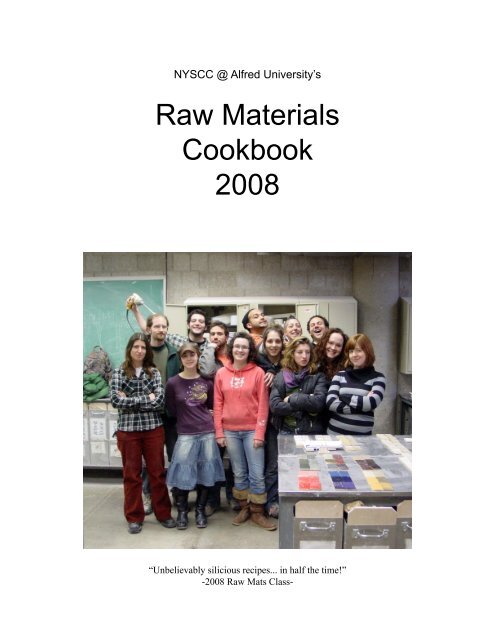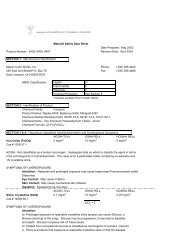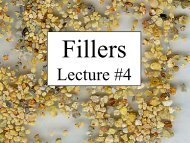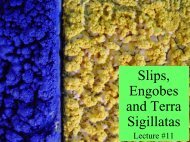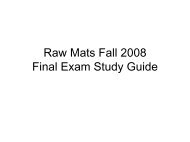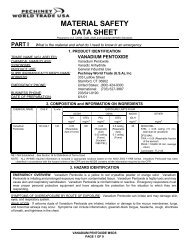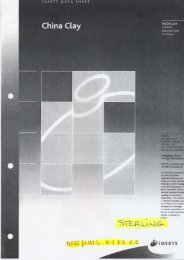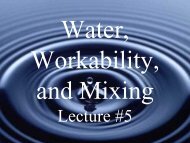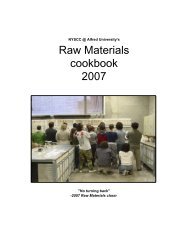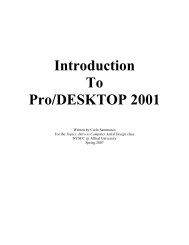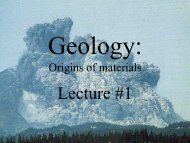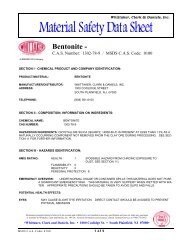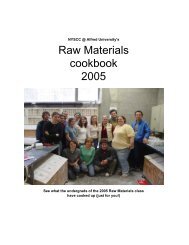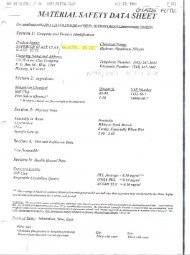Raw Materials Cookbook 2008 - Alfred's Clay Store - Alfred University
Raw Materials Cookbook 2008 - Alfred's Clay Store - Alfred University
Raw Materials Cookbook 2008 - Alfred's Clay Store - Alfred University
- No tags were found...
Create successful ePaper yourself
Turn your PDF publications into a flip-book with our unique Google optimized e-Paper software.
NYSCC @ <strong>Alfred</strong> <strong>University</strong>’s<strong>Raw</strong> <strong>Materials</strong><strong>Cookbook</strong><strong>2008</strong>“Unbelievably silicious recipes... in half the time!”-<strong>2008</strong> <strong>Raw</strong> Mats Class-
<strong>Raw</strong> Mats - Fall <strong>2008</strong> - Carlo Sammarco - NYSCC @ <strong>Alfred</strong> <strong>University</strong>Name:Purpose of Research:Firing Range:Allison Craver & Caitlin O’BrienA colored casting bodyCone 3Recipe(s):Revised Wally’s WonderslipGoldArt 21Tennessee #10 10EPK 12Custer Feldspar 24Frit 3124 8Flint 25Total 100%Darvan #7 1.016%Water ?Revised Wally’s Wonderslip(adjusted for colorants)GoldArt 18.9Tennessee #10 9.0EPK 10.8Custer Feldspar 21.6Frit 3124 7.2Flint 22.5Colorant 10Total 100%Darvan #7 1.016%Water ?Development:In order to conserve energy, several professors and practicing artists at <strong>Alfred</strong> <strong>University</strong> have startedfiring at lower temperatures. It will be important to have a full catalog of new recipes that have beentested and proven at these temperatures—which is why we chose to develop a body for Cone 3. Thegoal of our research was to create a Cone 3 casting body for both functional and sculptural wares. Weintended to make a body to add colorants to. Once we had a working recipe, adding colorants would bean easy way to control the color of the body.We used a revised version of Wally’s Wonderslip to encourage the formation of more glassin the body. Our results were difficult to interpret because the kilns under-fired each time. Our firstcast samples (using the Revised Wally’s Wonderslip for Colorants) felt smooth and chalky and whentapped and emitted a dull tone rather than a high ping usually associated with fired ceramics. Shrinkageand Absorption tests were performed on the set of cast samples. Shrinkage was minimal but the tilesabsorbed up to 19%, which could be a result of under-firing but was discouraging nonetheless. A secondset of samples were cast, fired, and glazed with several different Cone 3 glazes. The body reacted well toglazing, there was no crazing or shivering but again the kiln did not reach temperature and the glaze wasunder-fired. Overall the Revised Wally’s Wonderslip recipe produced promising results for Cone 3 andwith a little more research to confirm these results could be a valuable addition to recipe books.1
<strong>Raw</strong> Mats - Fall <strong>2008</strong> - Carlo Sammarco - NYSCC @ <strong>Alfred</strong> <strong>University</strong>Drops ofDarvan #7Revised Wally’s Wonderslip(viscosity notes)Observations2 Thick Paste4 Paste6 Slightly Thinner - still quite thick8 No noticeable change10 Still think, but beginning to smooth out12 Slightly thinner14 Noticeably thinner16 No change18 Consistency of a milkshake20 --- not tested ---22 Could be poured, still thick24 Consistency of cream26 Noticeably thinner28 Thin, runs off stirrer30 Slightly thinner32 Slightly thinner34 Beginning to become runny36 Slightly thinner38 No change40 No change42 No change44 No change46 No change48 Slightly thicker50 No noticeable changeRevised Wally’s Wonderslip(short term gelling and settling notes / 25 minute test)Drops of ObservationsDarvan #734 Thick layer on bottom, but no gelling / no settling36 Somewhat gelled / no settling38 No gelling / no settling40 No gelling / no settling42 No gelling / no settling44 No gelling / no settling46 No gelling / no settling48 No gelling / no settling50 No gelling / no settling2
<strong>Raw</strong> Mats - Fall <strong>2008</strong> - Carlo Sammarco - NYSCC @ <strong>Alfred</strong> <strong>University</strong>Revised Wally’s Wonderslip(long term gelling and settling notes / overnight test)Drops of ObservationsDarvan #734 Fully gelled / no settling36 Fully gelled / no settling38 Somewhat gelled / no settling40 Somewhat gelled / no settling42 Somewhat gelled / no settling44 Hardly gelled / no settling46 Hardly gelled / no settling48 Not gelled / no settling50 Not gelled / no settlingDrops ofDarvan #7Revised Wally’s Wonderslip(casting tests / 25 minutes in a mold)Amount of ObservationsDarvan #734 0.86% gelled before casting time – not good36 0.91% OK, maybe too gelled at 25 min..38 0.96% good40 1.016% good, best?42 1.07% goodDrops ofDarvan #7Revised Wally’s Wonderslip(absorption tests / completed on tiles fired to cone 3)Amount ofDarvan #7Absorption34 0.86% 18.4%36 0.91% 18.7%38 0.96% 17.7%40 1.016% 19%42 1.07% 18%Drops ofDarvan #7Revised Wally’s Wonderslip(shrinkage tests / completed on tiles fired to cone 3)Amount ofDarvan #734 0.86% 3%36 0.91% 3%38 0.96% 3%40 1.016% 4%42 1.07% 6%Total Shrinkage3
<strong>Raw</strong> Mats - Fall <strong>2008</strong> - Carlo Sammarco - NYSCC @ <strong>Alfred</strong> <strong>University</strong>Castings done with increasing amounts of Darvan (drops of Darvan from left to right: 34, 36, 38, 40,42).Castings done with 34 drops (0.86%) of Darvan on the left and 40 drops (1.016%)on the right. Note that the sample on the left coagulated, which prevented the slipfrom draining properly during casting. The additional Darvan on the right helpeddestroy this coagulation, allowing for better drainage.Castings of a house done using the final recipe (with 1.016%Darvan).Inside of house object. The smoothsurfaces suggest good drainage.4
<strong>Raw</strong> Mats - Fall <strong>2008</strong> - Carlo Sammarco - NYSCC @ <strong>Alfred</strong> <strong>University</strong>Name:Purpose of Research:Firing Range:Recipe(s):Sharie Willey and Nicole TruisiPhotoluminescent ceramicsUp to C. 10 Ox., Red, and microwaveNeodymium sulfatePraseodymium sulfateEuropium sulfateTerbium sulfateYtterbium sulfateDevelopment:The purpose of this research was to investigate Photoluminescence using ceramic materials fired under avariety of atmospheric firing conditions.We began the test series using two different substrates: tape-cast alumina and a recently developedporcelain body (body #1 from this year’s potluck bodies) which we’ll call C&J’s Porcelain.Each of the materials used started off as sulfate powders which were diluted to varying degrees using tapwater. These were applied to the substrates in such a way that each one would be mixed with each of theothers, as well as a pure sample of each by itself (see graph on following page).Three of the alumina substrates were fired in the kiln room in Harder under both reduction and oxidationconditions. We then fired 2 of each substrate in a microwave kiln at the Ceramics Corridor, with GaryDelRegno firing the kiln as we audited the process.The alumina tiles were very fragile and broke apart not only during firing (microwave), but also as itwas cooled. This type of application requires some degree of porosity of the substrate, which is notpresent with this type of tile. As a result, a visible amount of powdered element substance resulted fromlack of absorption into the tile after the firing.The C&J Porcelain tiles were first fired in Harder Hall to get them to a vitreous state for betterapplication. One tile was clear glazed and fired again, and the other was clear glazed and unfired. Theapplication of the elements onto the glaze-fired tile resulted in the substance sitting on the top of thetile and not spreading out. The raw-glazed tile caused the substance to soak into the glaze, giving it amore spread-out effect. These tiles held up well under the microwave firing, with a small amount ofslumping, which is to be expected given the rate of climb and temperature reached (refer to graph).5
<strong>Raw</strong> Mats - Fall <strong>2008</strong> - Carlo Sammarco - NYSCC @ <strong>Alfred</strong> <strong>University</strong>NdNdTb Tb+Nd TbEu Eu+Nd Eu+Tb EuPr Pr+Nd Pr+Tb Pr+Eu PrYt Yt+Nd Yt+Tb Yt+Eu Yt+Pr YtNd Tb Eu Pr YtLegend for all test tilesIn the above table, the following abbreviations are used:Nd = NeodymiumTb = TerbiumEu = EuropiumPr = PraseodymiumYt = Ytterbium6
<strong>Raw</strong> Mats - Fall <strong>2008</strong> - Carlo Sammarco - NYSCC @ <strong>Alfred</strong> <strong>University</strong>C&J’s porcelainMicrowave firingShort-wave UVLong-wave UV7
<strong>Raw</strong> Mats - Fall <strong>2008</strong> - Carlo Sammarco - NYSCC @ <strong>Alfred</strong> <strong>University</strong>Alumina substrateUnknown firing (not microwave)Short-wave UVLong-wave UV8
<strong>Raw</strong> Mats - Fall <strong>2008</strong> - Carlo Sammarco - NYSCC @ <strong>Alfred</strong> <strong>University</strong>Alumina substrateReduction on the left; Oxidation on the right.Short-wave UVRegarding the test tiles under UV illumination:Both sets of tiles showed varying degrees of photoluminescence (refer to photo documentation). Thesewere viewed under Short Wave UV (254nm) and Long Wave UV (356nm).The C&J Porcelain tiles were again found to be more practical. In this case because the aluminatiles seemed to absorb the UV light, affecting the visual results to a small degree. This, along withthe porosity issue caused the C&J Porcelain to achieve much brighter results. We also found thatilluminating the substrates while placed on a matte black surface created a more accurate result.9
<strong>Raw</strong> Mats - Fall <strong>2008</strong> - Carlo Sammarco - NYSCC @ <strong>Alfred</strong> <strong>University</strong>1 4 0 01 2 0 01 0 0 0Temperture (C)8 0 06 0 04 0 02 0 000.874.959.0313.117.221.325.429.433.537.641.745.849.853.95862.166.270.274.378.482.586.690.694.798.8103107111115119123127131136140144148152Time (minutes)The information in the chart above was collected from equipment which monitored the microwave duringthe firing of our samples. Total firing time was 154 minutes. Top recorded temperature was 1301 o C(2373 o F). However, due to discrepancies in thermal couple equipment, we believe the top temperaturewas actually closer to 1538 o C (2800 o F).Nameplate from the UV light used for documentation(both short and long-wave UV).Gary and Sharie (Crash), chillin by the microwave.10
<strong>Raw</strong> Mats - Fall <strong>2008</strong> - Carlo Sammarco - NYSCC @ <strong>Alfred</strong> <strong>University</strong>Pre fired tests loaded in sagger. Colors are dueto food colorants added to each sulfate for easiervisualization of the application process.Fiber blanket was used to help retain heat andreach temperature faster.Samples after firing in the sagger.Crucible cooling after firing (note whitehotcrack).CONCLUSION:The tests were a huge success and will be ongoing in various forms. We will continue to use theC&J Porcelain in future tests, as well as different methods as it applies to application, firing, dilutionand substrate material. Concerning the tiles, we will attempt to achieve much thinner tiles for futureexploration with translucency of the porcelain.11
<strong>Raw</strong> Mats - Fall <strong>2008</strong> - Carlo Sammarco - NYSCC @ <strong>Alfred</strong> <strong>University</strong>Name:Purpose of Research:Firing Range:Recipe(s):James PastoreCompatibility between stoneware throwing and casting bodiesCone 10 OxVarious (see below)...Development:With throwing at the heart of my studio practice I decided to develop a casting body that wouldcomplement pots from the wheel. The goal of these tests was to find a compatible casting body thatwould shrink at the same rate as #570 and not have problems with cracking and shrinking. This wouldensure much cleaner, professional attachments of handles, springs, spouts, etc…I used Linda’s 570 stoneware in its original state and then created three revisions. The casting revisionsprogressively decreased the surface area of the #570 body in order to shorter casting times. Thiswas done by adding increasing amounts of Velvacast in each recipe. Also, the amount of Custer wasincreased to help melt the velvacast because it is cleaner and has fewer alkalis. The amount of grogremained the same in all the recipes, so settling changed from test to test.Original #570Hawthorn bond 35 24.85EPK 16.56Om-4 12.42GoldArt 24.85Custer Feldspar 8.28Fine Grog 13.04Total 100%Darvan #7 0.762%Water ?Surface Area 19.08 m 2 /gm12
<strong>Raw</strong> Mats - Fall <strong>2008</strong> - Carlo Sammarco - NYSCC @ <strong>Alfred</strong> <strong>University</strong>Drops ofDarvan #7Original #570Observations2 very thick / doesn’t move4 same6 thick slip8 same10 same12 same14 thinner / thick like custard16 same18 same20 a lot thinner / like yogurt22 thinner24 thinner26 thinner / heavy cream28 same30 thinner / IDEAL FOR CASTING32 little thinner34 MINIMUM VISCOSITY36 same38 sameAt the ideal consistency (30 drops of Darvan; 0.762%) with 15 minutes of sitting, original #570 almostcompletely gelled.#570 Revision 1Velvacast 12.22Hawthorn bond 35 20.25EPK 13.50Om-4 10.12GoldArt 20.25Custer Feldspar 10.62Fine Grog 13.04Total 100%Darvan #7 0.66%Water ?Surface Area 17.03 m 2 /gm13
<strong>Raw</strong> Mats - Fall <strong>2008</strong> - Carlo Sammarco - NYSCC @ <strong>Alfred</strong> <strong>University</strong>Drops ofDarvan #7#570 Revision 1Observations2 thick4 thick6 thick8 thick10 thick12 thinner14 thinner but still doesn’t move16 thinner / thick pudding18 same20 a lot thinner / still on the thick side but pourable22 thinner24 thinner26 IDEAL FOR CASTING28 thinner30 MINIMUM VISCOSITY32 same34 same36 same38 same40 sameAt the ideal consistency (26 drops of Darvan; 0.66%) with 15 minutes of sitting, #570 Revision 1 onlypartially gelled! No significant settling.#570 Revision 2Velvacast 24.65Hawthorn bond 35 15.57EPK 10.38Om-4 7.78GoldArt 15.57Custer Feldspar 13.01Fine Grog 13.04Total 100%Darvan #7 0.66%Water ?Surface Area 14.95 m 2 /gm14
<strong>Raw</strong> Mats - Fall <strong>2008</strong> - Carlo Sammarco - NYSCC @ <strong>Alfred</strong> <strong>University</strong>Observations#570 Revision 2Same results as revision #1. 26 drops of darvanis ideal for casting and 30 is minimum. Theonly difference was more settling.#570 Revision 3Velvacast 37.15Hawthorn bond 35 10.86EPK 7.24Om-4 5.43GoldArt 10.86Custer Feldspar 15.42Fine Grog 13.04Total 100%Darvan #7 0.66%Water ?Surface Area 12.85 m 2 /gmObservations#570 Revision 3Again, same results as revision #1. 26 drops ofdarvan is ideal for casting and 30 is minimum.However, this showed even more settling thanthe previous two tests.For Revision 3 I also did a Thixotropy test by timing how long 250 ml. of the casting slip took to pourout of 6 mm hole. Time differences are due to thixotropy.Viscosity 1: 22 sec.Viscosity 2: ( 5 minutes of settling) 29 sec.Thixotropy: 24The above references the Thixotropy test on pg. 297 of The Ceramic ProcessThe Ceramic Process, Anton Reijnders, A&C Black Publishers Limited, 200515
<strong>Raw</strong> Mats - Fall <strong>2008</strong> - Carlo Sammarco - NYSCC @ <strong>Alfred</strong> <strong>University</strong>Series of tests. All bowls were thrown using #570 boxed clay. Castingsinside the bowls from left to right: Original #570, #570 Revision 1, #570Revision 2, #570 Revision 3.Original #570 Detail of Original #57016
<strong>Raw</strong> Mats - Fall <strong>2008</strong> - Carlo Sammarco - NYSCC @ <strong>Alfred</strong> <strong>University</strong>#570 Revision 1 Detail #570 Revision 1#570 Revision 2 Detail #570 Revision 2#570 Revision 3 Detail #570 Revision 317
<strong>Raw</strong> Mats - Fall <strong>2008</strong> - Carlo Sammarco - NYSCC @ <strong>Alfred</strong> <strong>University</strong>Note the difference in color between Original #570 on the left and #570 Revision 3 on the right.Homemade apparatus for recording theviscosity of slip.18
<strong>Raw</strong> Mats - Fall <strong>2008</strong> - Carlo Sammarco - NYSCC @ <strong>Alfred</strong> <strong>University</strong>Name:Purpose of Research:Firing Range:Recipe(s):T.J. & Chen FeiSlip casting BodyCone 046 Tile 13.1Tennessee 10 13.1EPK 26.2Frit 3124 33.9Flint 4.1Molochite 200 mesh 11.3Add:Darvan 7 1.7%Water 43%Development:Our Goal was to develop a slip casting body that was compatible to our earlier developed potluckthrowing and hand building body at cone 04.The results were excellent. The bodies were definitely compatible. There was no visible sagging orwarping and minimal cracking. The cracking that did occur was right on a seem where the slip castingbody met the hand built body, however the cracking could have been avoided with better welded seems.The only negative to the body was a slow release time from the mold. On average, the object took anhour to release.In future tests we would like to test adding fibers to the casting body. It was not applicable to try doingso at this point because of our limited experience casting. We found that our time was better spentexploring the basics of casting before trying anything too foreign.Cast objectDetail of Cast object19
<strong>Raw</strong> Mats - Fall <strong>2008</strong> - Carlo Sammarco - NYSCC @ <strong>Alfred</strong> <strong>University</strong>Cast object with hand built attachmentAlternate view of cast object withhand built attachmentAlternate view of cast object with handbuilt attachment (second variation)Cast object with hand built attachment(second variation)Detail view of cast object with handbuilt attachment (second variation)20
<strong>Raw</strong> Mats - Fall <strong>2008</strong> - Carlo Sammarco - NYSCC @ <strong>Alfred</strong> <strong>University</strong>Name:Purpose of Research:Firing Range:Kaye WaltmanCrawling layered glaze for bisque applicationCone 6 Ox and ReRecipe(s):Preferred Final Recipes (a complete list of recipes tested is found on the next page):Lana’s Ball Crawl (LBC)Neph. Sy. 60%Magnesium Carb. 22OM-4 18Wirt ShinoNeph. Sy. 45Kona F-4 10.8EPK 20OM-4 15.2Soda Ash 19Redart 66<strong>Clay</strong> bodies used:#444 StonewareHB 35 38.1%Goldart 23.81OM-4 23.81G-200 9.52Sand 4.76Group 1 Porcelain (from this cookbook)Ultrafine H 43.6%Tennessee #10 9.7G-200 32.8Flint 10.9Veegum 3.0Val Cushing’s “Easy”StonewareGoldart 30%Hawthorn 30Lizella 40Development:I wanted to develop a crawling slip that could be used in combination with glazes to alter their textureand color. I started by testing 15 shino glazes that came from reputable sources. I chose shinos becausethey tend to crawl when applied too thick due to high clay content and are somewhere between a glazeand a slip in formula. I tested the glazes in Oxidation and Reduction at ^6. Also, I tested each glaze overthree different bodies: Val Cushing’s Easy stoneware, #444, and group #1’s porcelain from <strong>2008</strong>.Two glazes had the results I was looking for (Lana’s Ball Crawl and Korean 22 shino), while otherswere glassy with no crawling. I then tested the crawling glazes and the glassy glazes together forthickness and layering pattern (over-under, under-over) and found three combinations that yielded mydesired results. These glazes were then tested a retested and fired vertically and on cups to determinethe possibilities of actual use on pots.My final product is a dark shinny glaze that has dramatic crawling when thickly applied. The edges ofLBC curl up over the Wirt and melt in, creating white highlights and leaving bare clay in between beadsof glaze. I would like to do color tests using LBC and then test those with layering glazes to alter colorsand breaking patterns of color in the way that the white and brown function in these test tiles.21
<strong>Raw</strong> Mats - Fall <strong>2008</strong> - Carlo Sammarco - NYSCC @ <strong>Alfred</strong> <strong>University</strong>1 2 3 4 5 6 7 8 9 10 11 12 13 14 15Neph Sy 45 39 40 60 31.5 54.5 45 40 88 40Kona F-4 10.8 9 9.4 15 17 10.8 10Spodumene 15.2 9 22.8 10 17.3Lithium Carb. 6.5 4 5Soda Ash 4 16 12 7 2.9 19 5 43134 40 33Gerstley Borate 18.7 35 4.9Custer Feldspar 12 60 20Barium Carb. 5Dolomite 5Whiting 3 1 10 10Zinc Ox. 10Magnesium Carb. 22 26Flint 8 9.4 10 10Tin Oxide 13 7UltroxOm-4 15 13 15 18 15 14.9 15.2 10 3 14.7EPK 10 17 8 24.5 20 10 9 4Alberta <strong>Clay</strong> 56Redart 6 30 53 3 66Red Iron Oxide 1 2Total 100 100 91 122 100 100 90 100 117 100 100 176 85 100 100In the above table, the following abbreviations are used:1 = Gustin Crawl Shino2 = Malcolm Davis Shino3 = Falls Creek Shino Ababi #64 = Falls Creek Shino Ababi #25 = Falls Creek Shino6 = Orange Carbon Trap Shino7 = Adam’s Shino8 = Lana’s Ball Crawl9 = Korean 2210 = Revised K Shino11 = Clausen Shino12 = Wirt13 = Sam’s14 = Traditional15 = Carbon Trap22
<strong>Raw</strong> Mats - Fall <strong>2008</strong> - Carlo Sammarco - NYSCC @ <strong>Alfred</strong> <strong>University</strong>ReductionGroup #1Porcelain#444StonewareVC EasyStonewareOxidationGroup #1Porcelain#444StonewareVC EasyStonewareAll tiles 3 coats brushedOrange Carbon TrapClousen shino23
<strong>Raw</strong> Mats - Fall <strong>2008</strong> - Carlo Sammarco - NYSCC @ <strong>Alfred</strong> <strong>University</strong>Traditional shinoSam’s shinoGustin Crawl shinoRevised Korean shino24
<strong>Raw</strong> Mats - Fall <strong>2008</strong> - Carlo Sammarco - NYSCC @ <strong>Alfred</strong> <strong>University</strong>Carbon Trap shinoMalcolm’s shinoFalls Creek shinoAdam’s shino25
<strong>Raw</strong> Mats - Fall <strong>2008</strong> - Carlo Sammarco - NYSCC @ <strong>Alfred</strong> <strong>University</strong>Falls Creek Ababi 2 Falls Creek Ababi 6Wirt shinoLana’s Ball Crawl26
<strong>Raw</strong> Mats - Fall <strong>2008</strong> - Carlo Sammarco - NYSCC @ <strong>Alfred</strong> <strong>University</strong>Korean 22Top left to right: Lana’s Ball Crawl with FallsCreek 6 over top thin and thick; Falls CreekAbabi 6 with Lana’s Ball Crawl over top.Bottom left to right: Korean 22 with FallsCreek 6 over top thin and thick; Falls CreekAbabi 6 with Lana’s Ball Crawl over top.Top left to right: Lana’s Ball Crawl with FallsCreek shino over top thin and thick; Falls Creekshino with Lana’s Ball Crawl over top.Bottom left to right: Korean 22 with Falls Creekshino over top thin and thick; Falls Creek shinowith Korean 22 over top.Top left to right: Lana’s ball crawl with Adam’sshino over top thin and thick; Adam’s shinowith Lana’s ball crawl over top.Bottom left to right: Korean 22 with Adam’sshino over top thin and thick; Adam’s shinowith Korean 22 over top.27
<strong>Raw</strong> Mats - Fall <strong>2008</strong> - Carlo Sammarco - NYSCC @ <strong>Alfred</strong> <strong>University</strong>Top left to right: Lana’s Ball Crawl with Wirtshino over top thin and thick; Wirt shino withLana’s Ball Crawl over top.Bottom left to right: Korean 22 with Wirt shinoover top thin and thick; Wirt shino with Korean22 over top.Left to right: Korean 22 with Falls Creek shinoover top; Lana’s Ball Crawl with Wirt shinoover top; Korean 22 with Wirt shino over top.Lana’s Ball Crawl with Wirt shino overtop.Detail of Lana’s Ball Crawl with Wirt shinoovertop.28
<strong>Raw</strong> Mats - Fall <strong>2008</strong> - Carlo Sammarco - NYSCC @ <strong>Alfred</strong> <strong>University</strong>Korean 22 with Wirt shino overtop.Detail of Korean 22 with Wirt shino overtop.Falls Creek shino with Korean 22 overtop.Detail of Falls Creek shinowith Korean 22 overtop.Korean 22 on the outside and Adam’s shinoon the inside - VC easy stoneware body.Detail of Korean 22 on VC easy stonewarebody.29
<strong>Raw</strong> Mats - Fall <strong>2008</strong> - Carlo Sammarco - NYSCC @ <strong>Alfred</strong> <strong>University</strong>Lana’s Ball crawl Korean 22 Revised KoreanFalls Creek Ababi 2. The originalrecipe called for an opacifier butit wasn’t used in this test.30
<strong>Raw</strong> Mats - Fall <strong>2008</strong> - Carlo Sammarco - NYSCC @ <strong>Alfred</strong> <strong>University</strong><strong>Raw</strong> MatsHonorableMentionFalls Creek Ababi 6. The original recipe called for opacifierbut it wasn’t used in this test.31
<strong>Raw</strong> Mats - Fall <strong>2008</strong> - Carlo Sammarco - NYSCC @ <strong>Alfred</strong> <strong>University</strong>Name:Purpose of Research:Firing Range:Cassandra J. KellamColored throwing bodiesCone 6Recipe(s):#444 Original #444 Variation 1 #444 Variation 2Hawthorn 35 38.10 38.10% 38.1Gold Art 23.81 23.81% 23.81OM-4 23.81 23.81% 23.81G-200 9.52 14.28%Neph . Sy. 9.52Sand 4.76 4.76100% 100% 100%#570 Original #570 Variation 1 #570 Variation 2Hawthorn 35 24.85 24.85 24.85Gold Art 24.85 24.85 24.85OM-4 12.42 12.42 12.42EPK 16.56 16.56 16.56Custer 8.28 2.76Neph . Sy. 10.28 10.28Flint 2.76Fine Grog 13.04 8.28 8.28100% 100% 100%For the colored clays, I added 2-10% of the colorants Red Iron Oxide, Yellow Ochre,and Pearl ash (Potassium Carbonate).Development:The goal of the research was to acquire a rich color from the clay body when fired to temperature.First, the cone 10 #570 and #444 clay bodies were both modified with different glass formers.Ultimately, each was assigned two variations. I mixed 400g. 6 different clays (including the originalbodies so I would be able to compare them with the new ones) in total and made two tiles for each, onefor oxidation and one for reduction. After the firing, I did a porosity test on all of the oxidation tiles inorder to figure out which was the densest for the #570 and the #444. Upon finding the densest variation,I proceeded to use it to explore variations of the colorants: Yellow Ochre, Red Iron Oxide, and Pearl Ash(Potassium Carbonate) in 2% increments beginning at 2% and ending at 10% out of a total of 400g. Atthis point, I made 60 tiles altogether including 3 5-point line blends for each colorants in each of the twomodified clay bodies and a tile for each test at oxidation and reduction.32
<strong>Raw</strong> Mats - Fall <strong>2008</strong> - Carlo Sammarco - NYSCC @ <strong>Alfred</strong> <strong>University</strong>I received the richest results from the #444 modified clay body fired at oxidation. My favorite colorswere from the Yellow Ochre line blend, while my least preferred were from the Pearl Ash, which was acomplete disappointment.Tests for the #570 body without colorants. Original recipe on top, with Variation 1 and 2 below. Oxidationon the left, reduction on the right.Tests for the #444 body without colorants. Original recipe on top, with Variation 1 and 2 below. Oxidationon the left, reduction on the right.33
<strong>Raw</strong> Mats - Fall <strong>2008</strong> - Carlo Sammarco - NYSCC @ <strong>Alfred</strong> <strong>University</strong>The #570 Variation 2 body with Red Iron Oxide additions in 2% increments from topto bottom. Oxidation on the left, reduction on the right.The #570 Variation 2 body with Yellow Ochre additions in 2% increments from topto bottom. Oxidation on the left, reduction on the right.34
<strong>Raw</strong> Mats - Fall <strong>2008</strong> - Carlo Sammarco - NYSCC @ <strong>Alfred</strong> <strong>University</strong>The #570 Variation 2 body with Pearl Ash additions in 2% increments from top tobottom. Oxidation on the left, reduction on the right.The #444 Variation 1 body with Red Iron Oxide additions in 2% increments from topto bottom. Oxidation on the left, reduction on the right.35
<strong>Raw</strong> Mats - Fall <strong>2008</strong> - Carlo Sammarco - NYSCC @ <strong>Alfred</strong> <strong>University</strong>The #444 Variation 1 body with Yellow Ochre additions in 2% increments from topto bottom. Oxidation on the left, reduction on the right.The #444 Variation 1 body with Pearl Ash additions in 2% increments from top tobottom. Oxidation on the left, reduction on the right.36
<strong>Raw</strong> Mats - Fall <strong>2008</strong> - Carlo Sammarco - NYSCC @ <strong>Alfred</strong> <strong>University</strong>Soda Ash’s solubility affected its drying characteristics.This view from the underside of the tilewith 10% Soda Ash, shows almost no deposit ofSoda Ash.The topside of the tile with 10% Soda Ash, shows soenough deposit that it created a glassy surface.Cross-section of the above tile shows migration ofSoda Ash to the surface.One of my favorite tests... #570 Variation 2 with 2%Yellow Ochre.37
<strong>Raw</strong> Mats - Fall <strong>2008</strong> - Carlo Sammarco - NYSCC @ <strong>Alfred</strong> <strong>University</strong>Name:Purpose of Research:Firing Range:Recipe(s):Sarah NikitopoulosVitreous engobe for bisque wareCone 5-6VariousFinal base recipe for all color variations:Nepheline Syenite 10OM-4 15EPK 15Frit 3110 30Flint 30Total 100%Add:CMC 1%Development:I wanted to develop an engobe for use on bisqued work that would vitrify a bit more than usual and nothave a chalky or dry surface. I was interested in something with a bit of an orange peel texture as well.For the first test I did a line blend of a basic recipe we developed using Nepheline Syenite, OM-4 Ball<strong>Clay</strong>, EPK, Frit 3110, and Flint in order to get a variety of different surfaces to choose from. Having30% clay in the recipe helped give strength and prevent major cracking when drying on the bisqued testtiles. The Nepheline Syenite and clays were kept constant while the frit and flint varied throughout thetests. I used boxed #444 clay for the test tiles and brushed the tests on from thick to thin, thick beingaround 4-5 millimeters. The result was a wide range of surfaces from a crazing, ice crystal looking glazeto a very dry, dusty surface that chipped off where thick.Test 1:Point # 1 2 3 4 5 6 7 8 9 10 11 12 13Neph. Sy. 10 10 10 10 10 10 10 10 10 10 10 10 10OM – 4 15 15 15 15 15 15 15 15 15 15 15 15 15EPK 15 15 15 15 15 15 15 15 15 15 15 15 15Frit 3110 60 55 50 45 40 35 30 25 20 15 10 5 0Flint 0 5 10 15 20 25 30 35 40 45 50 55 6038
<strong>Raw</strong> Mats - Fall <strong>2008</strong> - Carlo Sammarco - NYSCC @ <strong>Alfred</strong> <strong>University</strong>Results from Test 1:39
<strong>Raw</strong> Mats - Fall <strong>2008</strong> - Carlo Sammarco - NYSCC @ <strong>Alfred</strong> <strong>University</strong>Detail views of points from test 1 for further testing:Detail of point 2 fired in reduction.All of the engobes were difficult to brush on to the test tiles. They were very “dry” (like when brushingon a glaze), and held the streaks from the brush even after firing. I picked the three surfaces that I likedthe most; point 2, point 4, and point 7, and then performed a second round of testing (test 2) intending toincrease brushability by adding 1, 2, and 4 percent CMC gum as well as Epsom Salt .Brushability was noticeably improved with the additions of CMC. 1 percent seemed to be sufficient. 2and 4 percent made the engobe needlessly gummy and was hard to keep up a thick surface; as it dried itkept leveling out across the whole tile. There was little improvement with the Epsom salt, it thickenedup the engobe yet it was still very “dry” when brushed on. Test 2 also served as a trial to see howconsistent the engobes would be from firing to firing; results from test 2 were similar to test 1 except forcrawling in the very thick areas due to adding the CMC.40
<strong>Raw</strong> Mats - Fall <strong>2008</strong> - Carlo Sammarco - NYSCC @ <strong>Alfred</strong> <strong>University</strong>Results from test 2:Comparison between adding 4% CMC (left) and Epsom Salt (right) in point 2. Note the difficulty inestablishing thickness with the addition of 4% CMC.41
<strong>Raw</strong> Mats - Fall <strong>2008</strong> - Carlo Sammarco - NYSCC @ <strong>Alfred</strong> <strong>University</strong>For the third and final round of tests, I did a color run using point 7 from test 1 with a 1 percent additionof CMC. I added in increments of 1, 5, and 15 percent: Crocus Martis, Cobalt Carbonate, Dark Rutile,Copper Carbonate, Mason Dark Red stain, and Mason Sage stain. The tests for reduction yielded someinteresting results, but perhaps even more interesting were those for oxidation, as the kiln under firedand only reached cone 5. A few of the surfaces had the orange peel texture I was interested in. It isinteresting to note how some of the surfaces became a little glossier and smooth due to the colorantaddition acting as a flux, while others acted refractory and produced a more matte or pockmarkedsurface.Results from test 3:42
<strong>Raw</strong> Mats - Fall <strong>2008</strong> - Carlo Sammarco - NYSCC @ <strong>Alfred</strong> <strong>University</strong>Note metallic surfaces of Mason Sage in reduction.43
<strong>Raw</strong> Mats - Fall <strong>2008</strong> - Carlo Sammarco - NYSCC @ <strong>Alfred</strong> <strong>University</strong>Detail of 5% addition of Crocus Martis fired inoxidation. Under fired to cone 5Details of 15% addition of Cobalt Carbonate in reduction and oxidation. Oxidation test was underfired tocone 5.44
<strong>Raw</strong> Mats - Fall <strong>2008</strong> - Carlo Sammarco - NYSCC @ <strong>Alfred</strong> <strong>University</strong>Detail of 15% addition of Copper Carbonate fired in reduction.Detail of 5% addition of Copper Carbonate fired in oxidation. Under fired to cone5. Note the small chip in the cratering toward the bottom due to handling. This onlyseems to happen at a medium thickness; the cratering is quite dense and strong wherevery thick and is nearly impossible to puncture with a fingernail.45
<strong>Raw</strong> Mats - Fall <strong>2008</strong> - Carlo Sammarco - NYSCC @ <strong>Alfred</strong> <strong>University</strong>Detail of 15% addition of Mason Dark Red in reduction.As for further investigation, it could be worth testing other points along the test 1 line blend fordifferent surface options. A triaxial color run using multiple colorants may yield promising results.Point 2 from test 1 could be an interesting glaze when applied thick and would benefit from a color run.Firing variations could include firing to cone 5 in reduction, or re-testing all recipes at cone 5 or lower.Conversely, firing to cone 6 in oxidation may also yield interesting results.In closing, I’m not sure if these are technically considered engobes. Maybe they are more like matte ortextured glazes, but I’m pleased with the results regardless. Perhaps if a point was picked further downon the line blend in test 1 something closer to an engobe would have been achieved.46
<strong>Raw</strong> Mats - Fall <strong>2008</strong> - Carlo Sammarco - NYSCC @ <strong>Alfred</strong> <strong>University</strong><strong>Raw</strong> MatsEditor’sChoiceFrom test 1... Detail of point 2 fired in reduction.47
<strong>Raw</strong> Mats - Fall <strong>2008</strong> - Carlo Sammarco - NYSCC @ <strong>Alfred</strong> <strong>University</strong>Name:Purpose of Research:Firing Range:Recipe(s):Rachel EllsworthEgyptian paste with paper burnoutCone 04VariousSource of recipeHammer’s Daniel Susan Chappell Chappell Chappell ChappellEncyclopedia Rhodes Peterson EP-4 EP-7 EP-8 EP-10ψPage Number pg.115 pg. 319 pg.153 pg. 125 pg. 126 pg. 126 pg. 127Temperature C. 013-08 C. 08 C. 010-04 C. 08 C. 07 C. 06 C. 04Tests #1, A #2, B #3, C #4, D #5, E #6, F #7, GNeph. Sy.. 35 40 37 37 11 5Hommel 14 (3134) 20Soda Ash 10 6 6 5 5 15Sodium Bicarb. 6 6 6 5 5Borax 5Calcium Carb.. 5Talc 20Cornwall Stone 2.5Kaolin (EPK) 15 12 47 20Ball <strong>Clay</strong> (Tenn #10) 20 5 14 19 52.5Bentonite 8 5Flint 35 20 37 66 33 23Sand 8CMC 3Total 100 105 100 100 100 115 115Books cited for recipes:The Potter’s Dictionary of <strong>Materials</strong> and Techniques, Frank and Janet Hamer, Third edition, A & C Black Limited, 1993<strong>Clay</strong> and Glazes for the Potter, Daniel Rhodes, Third Edition, Krause Publications, 2000The Craft and Art of <strong>Clay</strong>, Susan Peterson, Fourth Edition, Laurence King Publishing Ltd, 2003The Potter’s Complete Book of <strong>Clay</strong> and Glazes, James Chappell, Revised Edition, Watson-Guptill Publications, 1991Development:I wanted to find a way to build using slip and paper, where the paper would burn out leaving a fragilelacy looking piece. I decided that it would make sense to use a self glazing body due to the fragility ofthe piece, and to the advantages of once-firing. I decided to work with Egyptian paste as a solution tothe once fire idea. I knew that adding colorants would change the recipes so I decided to do each samplewith a colorant and without.I started with 7 recipes for Egyptian paste, all with different firing ranges. Without changing theirrecipes, I wanted to see what they did at cone 04. I mixed 300g batches of each recipe twice. In onebatch of each of the seven recipes I added 3% of copper carbonate (designated A, B, C... etc in thisseries). In order to completely dissolve the Soda Ash and Sodium Bicarbonate, I made 14 containerswith 30% boiling water and added the Soda Ash first, let it dissolve and added the Sodium Bicarbonatesecond and let it dissolve. Those each sat while I dry mixed the rest of the recipes in separate containers48
<strong>Raw</strong> Mats - Fall <strong>2008</strong> - Carlo Sammarco - NYSCC @ <strong>Alfred</strong> <strong>University</strong>and then added them to the fully dispersed water. I added more water as necessary; wet mixed them andleft them out until they reached plasticity.<strong>Clay</strong>’s #6, #7, F, and G, took much longer to reach plasticity and clay’s #5 and E never did completelyhomogenize and dried on their surface, but stayed very wet on bottom so I did not continue on withthem, bringing my tests down to 12 bodies.The sodium in most of the bodies formed crystals all over the top surface that I just had to mix andwedge thoroughly back in to the clay body. These crystals are very important because they are whatform the glaze on the surface of the fired piece. From each of the clays I made tiles to test for slumpingbut recipes 3 and 4 cracked so I had to cut them shorter. In doing this, the tests didn’t show any slumpingbut later tests did, so I know my first tests should have been longer to show true slumping amount.The tests were helpful in that they showed the amount of self-glazing, that none of them wouldcompletely melt away at cone 04, the way they looked with and without a colorant, and how thecolorants would affect the make-up of the bodies. Bodies #7 and G did not fire completely out due tothe high percentage of Soda Ash in the recipe; some fuzzy crystallizing still remained on the surfaceafter firing (pictured below). The effect of the copper carbonate on #4 (aka D) would not be ideal for theway I wanted to use it, but still had an interesting effect that could be looked at further for other means(pictured below). The undersides of the colored bodies were a brown color where they dried last. Thisis where the sodium could not crystallize and cause a glazing effect. Further research could be done onhow rubbing the crystals off of some areas might be used esthetically to create variations in colors.A #1 B #2 C #3D #4 F #6 G #749
<strong>Raw</strong> Mats - Fall <strong>2008</strong> - Carlo Sammarco - NYSCC @ <strong>Alfred</strong> <strong>University</strong>Detail of Test #1Underside view of Test ADetail of Test DDetail of Test FDetail of Test #750
<strong>Raw</strong> Mats - Fall <strong>2008</strong> - Carlo Sammarco - NYSCC @ <strong>Alfred</strong> <strong>University</strong>From these tests, I chose three of the twelve with which to continue my research. The ones I chose were#4, A and C. From these I made 1000 gram samples in slip form without a dispersant. With each slipI did a series of tests by taking crumbled pieces of standard drawing paper and applying the Egyptianpaste in the following ways:1. Dipping it once2. Dipping it twice3. Dipping it three times4. Brush coating it once5. Brush coating it twice6. Brush coating it three timesWith these tests I was trying to see how well they kept their shape, how they looked around the edges,what the bottom looked like (where salts wouldn’t surface, causing no glaze), the best way to apply theslip to the paper and how much weight the paper could hold before losing its shape. Each sample didvarying things at each stage:Test #4 was very transparent and seemed to hold its shape better with less dipping and didn’t crack asmuch when applied thinner. This formula was amazingly transparent and held its shape very well. Itlooked calcified and bone like without containing any calcium based component. All variation on #4appeared flat matte with random small lightly glossed edges (not throughout entire piece). It was also theonly sample of the original 7 bodies that did not have soda ash.Dip applicationBrush application51
<strong>Raw</strong> Mats - Fall <strong>2008</strong> - Carlo Sammarco - NYSCC @ <strong>Alfred</strong> <strong>University</strong>Detail of test with 1 dipDetail of test with 1 brushed coatDetail of transparency on test with 1 brush coatRegarding recipe A, 1 dip didn’t cover enough surface area and 3 dips caused slumping. 1 brush coatcompletely melted because when paper burnt out it was too thin to hold its shape but it still made abeautiful spider web-like flat piece (pictured below). 2 dips seemed to work best. The edges on this piecehad teeth to them and were very jagged (pictured below). The copper did amazing things in the areas itpooled in and had a metallic dark silver to it. The blues in the thinner areas are gorgeous.Dip application52
<strong>Raw</strong> Mats - Fall <strong>2008</strong> - Carlo Sammarco - NYSCC @ <strong>Alfred</strong> <strong>University</strong>Brushed application (top view)Brushed application (side view)Detail of test with 2 dips. Note thepooled areas.Detail of test with 2 dips.Note the jagged edges.Detail of test with 1 brush coat53
<strong>Raw</strong> Mats - Fall <strong>2008</strong> - Carlo Sammarco - NYSCC @ <strong>Alfred</strong> <strong>University</strong>Recipe C was a lot like recipe A with the main difference being that C had both Soda Ash and Sodiumbicarbonate and A only had Soda Ash in it. This may be the cause of the tooth like edges on A. C doesnot have them at all. C’s edges are very smooth and the dipping effects were similar to A’s results (onecoat wasn’t enough, three was too many). The same thing happened with just one brush stroke in that itresulted in a pile resembling a flat spider web.Dipped applicationBrushed applicationDetail of test with 1brushed coat.Detail of test with 1 dipped coat.Underside of test with 2 brushedcoats.54
<strong>Raw</strong> Mats - Fall <strong>2008</strong> - Carlo Sammarco - NYSCC @ <strong>Alfred</strong> <strong>University</strong>From these results I chose my favorite of the three and did further research on how to build with them.I decided to work with recipe A because I really liked the jagged edge results. I made two 500 gramsamples, one with copper carbonate and one without. With each sample I varied ways of building. Iwanted to see how sturdy they would be when built, how much each piece would slump, if both sides ofpaper had to be painted in order for shape to be maintained, how different types of paper changed resultsand how they looked when layered.The following objects were made with the copper carbonate recipe, using specific techniques as describebelow...Paper Mache on round balloon (using tissuepaper covering entire balloon up to an inchbefore tie off)Detail of image on left.Larger piece of drawing paper oneside coated wrapped into a loopSmall piece of paperwrapped into loop withboth sides coated (usingnewsprint)55
<strong>Raw</strong> Mats - Fall <strong>2008</strong> - Carlo Sammarco - NYSCC @ <strong>Alfred</strong> <strong>University</strong>Crumpled piece dipped in slipplaced on top of other crumbledpiece dipped in slip withoutcopper carbonate.Detail of image on theleft.The following objects were made without copper carbonate recipe, using specific techniques as describebelow...Tissue paper coated in slip and layered tallas if brick-likeDetail of image on the left.Paper mache on long balloon base (bowllike).56
<strong>Raw</strong> Mats - Fall <strong>2008</strong> - Carlo Sammarco - NYSCC @ <strong>Alfred</strong> <strong>University</strong>I had some left over slip of #4 and, because I liked the effects of it from previous tests, I decided to tryit on a sheet of fiberglass someone had lying around. The effects were exactly the lacy idea I was goingfor. I plan to do further research on this idea and to see how I can build with it.Fiberglass dipped in #4.Detail of image on the left.Building with the paper mache worked well because it gave the paper a structure to harden around andthen release itself from while still maintaining its shape. The problem with the larger balloon was thatit kept popping too soon when the stuff was still too wet to maintain it shape. Coating one side of thepaper does not work even when done thick. Both sides need to be coated as done with smaller one thatstill remained its shape whereas the larger one completely burnt out and looked much like the sampleswhere only one brush coat was used. Layering the pieces on top of one another does not cause a lacy seethrough effect but looked more like a mound of opaque glass.Further testing with thicker paper might obtain more lacy results. I was very satisfied with my resultsbut would like to do further testing and perfect the best ways to work with the materials and find morematerials to use as well. Testing could go further in ways of building, color variations, how to use thinlycoated paper on pieces and possibly developing ways of transferring spider web look.57
<strong>Raw</strong> Mats - Fall <strong>2008</strong> - Carlo Sammarco - NYSCC @ <strong>Alfred</strong> <strong>University</strong>Name:Purpose of Research:Firing Range:Recipe(s):Callard GellerA slip for dipping and burning out packs of cigarettesCone 6 Ox.Foundry Hill Cream 10C+C Ball <strong>Clay</strong> 19Custer 20Flint 10Grolleg 25Tile 6 16Total 100%Add:Darvan 7 0.5%Epsom Salt Solution 0.05%Plus one of the following...Nylon Fibers 0.3%Paper Fibers 7.5%(rung slightly to remove water)Wollastonite 4.25%Development:I was trying to develop a slip body that would coat the packs of cigarettes and hold together as a paperburned out.I started by researching slip bodies, taking a cone 10 dipping slip and reformulating it to cone 6. I thendid a dispersant test to find right amount of Darvan 7. Additions of Epsom salt solved the problem ofthe slip pooling at the bottom of the objects. Having done this, I then experimented with additions ofdifferent fibers to hold slip together while the paper burned out.I did three line blends of different fibers. Paper and Wollastonite were more successful then nylon, withWollastonite being stronger in the end result.If I knew at the beginning what I know now, having done the tests, I would have figured out a moreconsistent way of dipping or spreading the slip in the packs of cigarettes.For future testing, I would suggest increasing the percent of fiber in the mix as well as developing somemix of fibers to hold the slip together. Also, figuring out some system for burning out the paper with outdisturbing the slip might prove more successful.58
<strong>Raw</strong> Mats - Fall <strong>2008</strong> - Carlo Sammarco - NYSCC @ <strong>Alfred</strong> <strong>University</strong>Before addition of Epsom Salt. Note the pooling of slip at bottom.After addition on Epsom Salt. Note that the burning out of the paper destroysthe slip.59
<strong>Raw</strong> Mats - Fall <strong>2008</strong> - Carlo Sammarco - NYSCC @ <strong>Alfred</strong> <strong>University</strong>Detail of ash created by burnt tinfoil inside cigarette pack.Pack with addition of Nylon FibersNote: Although was not strong enough tohole slip together in the amount nylon hadless of an affect on the texture on the finishedproduct.60
<strong>Raw</strong> Mats - Fall <strong>2008</strong> - Carlo Sammarco - NYSCC @ <strong>Alfred</strong> <strong>University</strong>Pack with addition of paper fiberNote: Stronger final product then nylon fiberhowever not as strong as Wollastonite.Pack with addition of Wollastonite. This wasthe strongest of tests, with the least crackingon surface. However, the Wollastonite alsodisrupted the texture of the slip.61
<strong>Raw</strong> Mats - Fall <strong>2008</strong> - Carlo Sammarco - NYSCC @ <strong>Alfred</strong> <strong>University</strong>Name:Purpose of Research:Firing Range:Haakon LenziWet application slipCone 6 Ox.Recipe(s):New Zealand Kaolin SlipUltrafine H 45.0Tennessee #10 10.0G-200 28.8Flint 16.2Total 100%White SlipTile 6 25EPK 25Grolleg 15Neph. Sy. 23Flint 12Total 100%Development:The purpose of my research was to come up with two different slips to be applied during theleather hard stage to the 570 body, commercial mason stains were then added for color. Oneof the two base slips was a whit slip, while the other used the New Zealand Kaolin.Mason Stains were added in 10% additions...Mason Dark Red- 10%Mason Nickel Silicate - 10%Mason Best Black- 10%Mason ZR VN Blue - 10%Mason Pink- 10 %Mason Violet- 10%After the initial testing of my base slips both slips broke on the edges of the test tiles. However these testwere only demonstration one dip. After adding the colorants to the slips, the test tiles were dipped twice.The second test showed that the fit was inadequate, as the slip flaked off most of the tiles. In the future Iwould modify the base slips to get a better fit as well as increase the percentage of mason stains.62
<strong>Raw</strong> Mats - Fall <strong>2008</strong> - Carlo Sammarco - NYSCC @ <strong>Alfred</strong> <strong>University</strong>For all samples: White Slip on the left, New Zealand Kaolin Slip on the right.Base slipsMason PinkMason VioletMason Zr Vn BlueMason Nickle Silicate63
<strong>Raw</strong> Mats - Fall <strong>2008</strong> - Carlo Sammarco - NYSCC @ <strong>Alfred</strong> <strong>University</strong>Mason Best BlackMason Dark RedDetail of Mason Violet on in White Slip baseDetail of Mason Violet on in New Zealand baseDetail of Mason Violet in New Zealand base.Flaking away sections reveal no contact withunderlying clay surface.Detail of Mason Best Black in New Zealandbase shows the curling and separation of slipfrom clay body64
<strong>Raw</strong> Mats - Fall <strong>2008</strong> - Carlo Sammarco - NYSCC @ <strong>Alfred</strong> <strong>University</strong>Class Evaluation of...Potluck <strong>Clay</strong> bodies65
<strong>Raw</strong> Mats - Fall <strong>2008</strong> - Carlo Sammarco - NYSCC @ <strong>Alfred</strong> <strong>University</strong>Developed by:Type:Color:Texture:Cone:Sharie and James (Group 1)ThrowingWhite (!)SmoothCone 6 Ox. or Re.Recipe:Ultrafine HTennessee #10G-200FlintVeegum43.69.732.810.93.0100%Wet to dry Shrinkage:Dry to fired Shrinkage:Total Shrinkage:8.6%10.2%18.8%Absorption:0.1%Class Ratings:Very Poor Poor Average Good Very Good1 2 3 4 5Throwing:(7 students surveyed)Plasticity 3.7Building Strength/ Resistance 3.4to slumpingHand Building:(3 students surveyed)Plasticity 4.0Building Strength/ Resistance 3.0to slumping66
What the critics are saying...“Holds form well with little cracking. Piecesattach nicely to one another.”“Cracked easily when pushed even slightly.Not fun to throw.”“Love it! Like ‘buttah’. Wouldadd less Veegum next time...”“...Strange drying properties...”“I compressed my objects well, but theystill cracked!”“Weird to work with (sticky)...but threw really well!”“It’s very slippery so I’m not sure it would be great for handbuilding. Press molds very nicely and really holds onto detail.”<strong>Raw</strong> Mats - Fall <strong>2008</strong> - Carlo Sammarco - NYSCC @ <strong>Alfred</strong> <strong>University</strong>“Body was nice to throw and hadgood vertical strength”.“Difficult to throw with but very beautiful.Perhaps just the nature of porcelain.”“Very smooth. Nicely vitrified anddense surface after fired. Had weirdcream cheese consistency like mostporcelains do.”67
<strong>Raw</strong> Mats - Fall <strong>2008</strong> - Carlo Sammarco - NYSCC @ <strong>Alfred</strong> <strong>University</strong>Developed by:Type:Color:Texture:Cone:Rachel and Sarah (Group 2)ThrowingBrownSemi-roughCone 04 Ox.Recipe:Lizella <strong>Clay</strong>C&C <strong>Clay</strong>EPKFrit 3124TalcFlintFine Grog29.9314.9614.9624.246.414.754.75100%Wet to dry Shrinkage:Dry to fired Shrinkage:Total Shrinkage:6.6%4.1%10.7%Absorption:0.69%Class Ratings:Very Poor Poor Average Good Very Good1 2 3 4 5Throwing:(7 students surveyed)Plasticity 3.0Building Strength/ Resistance 4.3to slumpingHand Building:(4 students surveyed)Plasticity 3.3Building Strength/ Resistance 4.3to slumping68
<strong>Raw</strong> Mats - Fall <strong>2008</strong> - Carlo Sammarco - NYSCC @ <strong>Alfred</strong> <strong>University</strong>What the critics are saying...“Great color... gets a little chalky as itdries out.”“Gritty body, a lot of tooth, a lot of wetstrength.”“Very groggy for throwing, buteasy to pull up.”“Cracks too much in press mold anddoesn’t show detail well because ofcracking.”“Some scumming on edges of piece(Didn’t affect glazing).”“This clay hurt my hands!”“Baby poop! Groggy. ThrewOK, but not as easy to form.”“Would not recommend forinexperienced throwers.”“Very resilient but the grog made this one painfulto throw for long periods of time.”“Some cracking when coil building. Holds formwell and pieces attach very nicely. Overall goodhand building body.”“Very ‘open’ when throwing. Haveto be careful not to use too muchwater.”69
<strong>Raw</strong> Mats - Fall <strong>2008</strong> - Carlo Sammarco - NYSCC @ <strong>Alfred</strong> <strong>University</strong>Developed by:Type:Color:Texture:Cone:Johnathan and Kaye (Group 3)ThrowingOff-whiteSmoothCone 6 Ox.Recipe:Foundry Hill CremeXX SaggerGoldart <strong>Clay</strong>CusterFlintFine Grog15.5415.5431.0821.0412.604.20100%Wet to dry Shrinkage:Dry to fired Shrinkage:Total Shrinkage:8.7%6.0%14.7%Absorption:1.17%Class Ratings:Very Poor Poor Average Good Very Good1 2 3 4 5Throwing:(8 students surveyed)Plasticity 4.0Building Strength/ Resistance 3.5to slumpingHand Building:(1 students surveyed)Plasticity 5.0Building Strength/ Resistance 5.0to slumping70
<strong>Raw</strong> Mats - Fall <strong>2008</strong> - Carlo Sammarco - NYSCC @ <strong>Alfred</strong> <strong>University</strong>What the critics are saying...“Very smooth and silky for a stoneware. Nicelightly speckled surface.”“Average body.”“I really enjoyed this body. Nice for throwing...beautiful fired color.”“Speckles!”“Press-molds very nicely and holds detail well. Cutssmoothly and wedges well.”“Average stoneware... a littleshort.”“Handles nicely and has goodworkability... attaches well,good for hand building, not verycoarse.”“Great stuff!”“Not great but not bad either.”“Held itself up in thin areas... good forpushing around... good for beginners,soft on the hands.”71
<strong>Raw</strong> Mats - Fall <strong>2008</strong> - Carlo Sammarco - NYSCC @ <strong>Alfred</strong> <strong>University</strong>Developed by:Type:Color:Texture:Cone:Allison and Caitlin (Group 4)ThrowingRedSmoothCone 04 Ox.Recipe:Redart <strong>Clay</strong>Yellow Banks #101OM-4Frit 3124TalcAdd:Barium Carbonate28.028.014.022.57.5100%0.4%Wet to dry Shrinkage:Dry to fired Shrinkage:Total Shrinkage:6.9%3.3%10.2%Absorption:0.64%Class Ratings:Very Poor Poor Average Good Very Good1 2 3 4 5Throwing:(6 students surveyed)Plasticity 3.0Building Strength/ Resistance 2.7to slumpingHand Building:(3 students surveyed)Plasticity 3.3Building Strength/ Resistance 3.7to slumping72
<strong>Raw</strong> Mats - Fall <strong>2008</strong> - Carlo Sammarco - NYSCC @ <strong>Alfred</strong> <strong>University</strong>What the critics are saying...“Generally average. Some slumping.Nice color.”“Color is great!”“...I also threw with it and like it better thanany red body I’ve ever thrown.”“I had a hard time constructing a handle. This clay kept cracking.Pinching seemed to work better than coil building.”“Press molds well with little cracking. Cutssmoothly and wedges nicely.”“This was lousy. It slumped a lot.”“Not impressed. Not a lot of wetstrength.”“Very hard to throw.”73
<strong>Raw</strong> Mats - Fall <strong>2008</strong> - Carlo Sammarco - NYSCC @ <strong>Alfred</strong> <strong>University</strong>Developed by:Type:Color:Texture:Cone:Callard and Haakon (Group 5)ThrowingBlueSemi-smoothCone 6 Re.Recipe:Helmer KaolinGrollegC&C <strong>Clay</strong>G-200FlintMolochite (200 mesh)Cobalt Oxide25.3125.319.9325.318.434.960.75100%Wet to dry Shrinkage:Dry to fired Shrinkage:Total Shrinkage:7.7%7.0%14.7%Absorption:0.76%Class Ratings:Very Poor Poor Average Good Very Good1 2 3 4 5Throwing:(8 students surveyed)Plasticity 3.3Building Strength/ Resistance 3.1to slumpingHand Building:(2 students surveyed)Plasticity 4.5Building Strength/ Resistance 4.5to slumping74
<strong>Raw</strong> Mats - Fall <strong>2008</strong> - Carlo Sammarco - NYSCC @ <strong>Alfred</strong> <strong>University</strong>What the critics are saying...“I really enjoyed this body. I felt in control.”“Beautiful color. Slumping was the only issue.”“Very plastic, dried quickly, easy to build with.Would recommend for hand building.”“Throws great... didn’t like the color.”“Not very good for press-molding. Doesn’t grabdetail well and tends to crack when pushed.”“Difficult to throw. Seemedweak. Also cracked easily.”“Love the blue.”“...I thought it threw the best!”“Nice to throw with. Very smooth like aporcelain without the annoying creamcheeseconsistency.”“Very hard to throw. Way too soft (maybe withmore drying time it would be better). Slumped,couldn’t keep shape while throwing.”Top tile was fired in oxidation; bottom tile was fired inreduction.75
<strong>Raw</strong> Mats - Fall <strong>2008</strong> - Carlo Sammarco - NYSCC @ <strong>Alfred</strong> <strong>University</strong>Developed by:Type:Color:Texture:Cone:Nicole and Cassandra (Group 7)Throwing and Hand buildingDark RedSmoothCone 6 Ox.Recipe:Redart <strong>Clay</strong>Yellow Banks #101Lizella <strong>Clay</strong>Hawthorne Bond (35 mesh)FlintFine GrogBlack Iron Oxide18.318.336.64.318.615.078.81100%Wet to dry Shrinkage:Dry to fired Shrinkage:Total Shrinkage:6.0%6.1%12.0%Absorption:0.58%Class Ratings:Very Poor Poor Average Good Very Good1 2 3 4 5Throwing:(8 students surveyed)Plasticity 2.9Building Strength/ Resistance 3.0to slumpingHand Building:(2 students surveyed)Plasticity 3.0Building Strength/ Resistance 3.5to slumping76
<strong>Raw</strong> Mats - Fall <strong>2008</strong> - Carlo Sammarco - NYSCC @ <strong>Alfred</strong> <strong>University</strong>What the critics are saying...“Dirties everything it touches. Presses OK, but showssmall cracks that can obscure detail.”“Not great... not awful. Difficult to attach hand buildpieces onto thrown pieces.”“Slumped, difficult to keep itsshape. Messy!”“Sticky and terribly messy to workwith. Great fired color!”“Cracked when used tothrow a slab.”“It was not pleasant to work withthis: there was a point I got to wherethe body was literally ripping”.“Strange texture.”“Short, very messy. Hard to throw visually. Hard tosee shape and detail while on the wheel.”77
<strong>Raw</strong> Mats - Fall <strong>2008</strong> - Carlo Sammarco - NYSCC @ <strong>Alfred</strong> <strong>University</strong>Developed by:Type:Color:Texture:Cone:T.J. Samuels and Chen Fei (Group 8)ThrowingOff-WhiteSmoothCone 04 Ox.Recipe:Tile-6Tennessee #10EPKFrit 3124FlintMolochite (200 mesh)12.8812.8825.7633.344.0311.11100%Wet to dry Shrinkage:Dry to fired Shrinkage:Total Shrinkage:6.2%6.3%12.5%Absorption:0.84%Class Ratings:Very Poor Poor Average Good Very Good1 2 3 4 5Throwing:(8 students surveyed)Plasticity 3.9Building Strength/ Resistance 3.9to slumpingHand Building:(3 students surveyed)Plasticity 4.0Building Strength/ Resistance 3.7to slumping78
<strong>Raw</strong> Mats - Fall <strong>2008</strong> - Carlo Sammarco - NYSCC @ <strong>Alfred</strong> <strong>University</strong>What the critics are saying...“One of the best! Don’t care for the color toomuch though.”“Perfect!”“Average. Okay to throw. Stood up relatively well tomanipulation after throwing.”“Seems to be very sensitive to how much water you add whilethrowing. Once you get the shape you want it is easy to alter.Very soft on the hands.”“Nice to work with.”“Very nice for throwing... I wishit weren’t low fire.”“Hard to get coils to stick (when coil building).Cracks easily.”“Great throwing body. Easy to pull up.A lot of wet strength.”“Favorite of all tests. Held shape well. Easy toform, no slumping - yay!”“Thin press molds are not as nicebecause of too much cracking...thicker press molds hold up muchbetter. Compresses nice.”79


